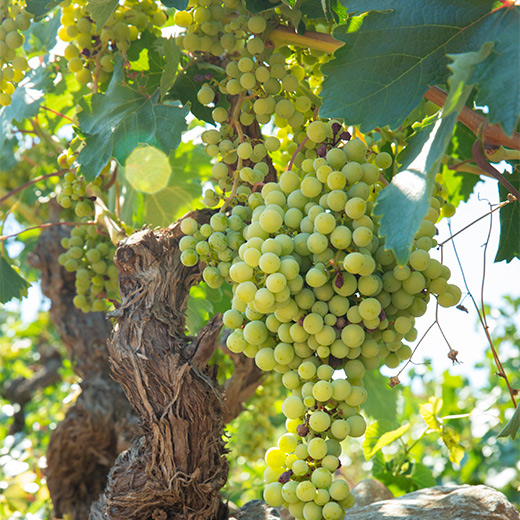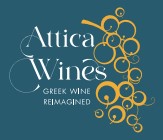
Savatiano is the single most important grape variety in Attiki and overall, the most planted variety in the Greek vineyard. It meets its finest expression in the low-yielding, old bush-trained, vines found throughout the different wine-growing areas of the prefecture. Such wines are placed in the category of Greece’s best whites that easily relay the message of local terroir. These are wines that clearly and loudly speak of their origin. A new generation of young winemakers are leaving their mark by producing a new wave of such exciting styles under the different PGI designations of Attiki. Innovation, tradition, experimentation, research, investment, passion and knowledge are the driving forces behind the grape’s recent transformation.
Savatiano, can be found under many different synonyms in different regions: Lefki Kontoura, Aspri Dobraina, Sakeiko, Savathiano, Perahoritiko are just a few of them. It has large compact clusters, with medium-sized berries. It is very resistant to drought and fungal diseases and ripens relatively late, in early to mid-September, depending on the year and location of the vineyard.
Eastern Attiki boasts an impressive number of old bush-vines planted on poor limestone soils. The old roots go very deep, the yields are naturally restricted by conditions and the wines display excellent depth of fruit and mineral characteristics. These are dazzling, unique, authentic wines with excellent ageing potential. Aged Savatiano is not a recent novelty. Long before the late-release versions currently on the market, the first aged Savatiano was produced long ago in 1935, as told in the book 'Andreas Kambas’, The Patriarch of Mesogeia'. A pioneer of the style of bottle aging for 8 years prior to its release. A stunning 200,000 bottles were produced.
Savatiano produces wines with moderate fruity aromas, reminiscent of apples, peaches and tropical fruits, such as melon and banana. Quite often there are also hints of flowers such as jasmine and citrus blossoms and some herbal undertones. The palate, is medium-bodied, with moderate, yet balanced acidity and develops greater complexity after a few years of bottle aging. This holds true especially for those wines that are sourced from older, low-yielding vines. As some of the latest quality bottlings indicate, Savatiano can age gracefully for up to a decade or more, developing aromas of honey, toasted nuts and a petrol-like minerality. Upon reaching full maturation, these wines develop a delicious, rich and extremely complex character. Some people compare them to the style of an aged Semillon from Hunter valley, but with lower acidity levels.
Savatiano is quite a versatile grape. Everything depends on the geographical region and the climate that will influence the spectrum of styles. In addition, and equally important are the technical choices made in the cellar. For example, wines from Keratea (PGI Attiki-ΠΓΕ Αττική) are usually more mineral and herbal in terms of style. In other regions, such as Markopoulo (PGI Markopoulo-ΠΓΕ Μαρκόπουλο) wines tend to be juicier and riper. Stamata (PGI Attiki-ΠΓΕ Αττική) is higher in altitude and has a cooler climate. The wines are lean and elegant with high acidity and moderate alcohol levels.
In general, there are two broad categories of styles. Some of the wines can be pleasantly fruity, easy drinking, with a great ratio of price to quality. However, Savatiano can be much more than just a simple, pleasant wine. Producers are seeking to create unique styles by working hard both in the vineyard and the winery. The resulting wines are fascinating, with extra layers of complexity and great depth. Vineyard age is considered to be very important as well as the low-yields and limestone soils. Lately, there has been an ongoing experimentation with barrel-fermented versions of Savatiano, skin-contact whites, and wines with minimal intervention. Another recent novelty is the release of older vintages from the wineries. These wines are left to age in the cellars and are sold as late releases, highlighting the variety’s ageing potential.
Retsina is an important chapter for Savatiano and nowadays there is a dynamic comeback of this traditional style. There are some wonderful expressions of PGI Retsina of Attiki (ΠΓΕ Ρετσίνα Αττικής) on the market. These wines are mostly based on the Savatiano grape variety.
Savatiano can also be blended with grape varieties such as Roditis, Assyrtiko and Malagousia. These blends are sold under the designation PGI Attiki (ΠΓΕ Αττική), or other local PGIs.
Savatiano’s food-friendly character
When it comes to food pairings, Savatiano is a versatile grape and can be paired with a multitude of different dishes. Fresh and fruity styles are ideal with poultry, vegetables, fish, shellfish and white cheese. Some great pairing ideas are fresh green salads, ratatouille, cheese and vegetable pies, sushi, calamari (especially fried), pasta with vegetables and roasted chicken.
A fattier and more mature style will be perfect with grilled, fish, slow-cooked pork, meat casseroles with vegetables, as well as with fried meatballs.
Retsina is the ultimate wine to accompany salted fish, feta cheese, fried cod, garlic filled dishes and different small plates or “mezedes”. Check a more detailed guide to pairings in the section of Retsina.



characteristics
Expressive moderate fruity aromas, reminiscent of apples, peaches and tropical fruits such as melon and banana. Quite often there are also hints of flowers such as jasmine and citrus blossoms and some herbal undertones. The palate, is medium-bodied, with moderate, yet balanced, acidity and complexity
bouquet
Wines that are sourced from low-yielding old vines can age gracefully for almost a decade, developing aromas of honey, wax, toasted nuts and petrol-like minerality. Reaching the plateau of maturation, these wines develop a delicious, rich and extremely complex character
- Pleasantly fruity, quaffing, with great value for money
- Complex with great depth and ageing potential
- Barrel-fermented
- Retsina
- Blends with other grapes
- Skin contact wines
- Wines of minimal intervention
- Fresh and fruity styles: poultry, vegetables, fish, shellfish and white cheese. Examples: fresh green salads, ratatouille, cheese or vegetable pies, sushi, calamari (especially fried), pasta with vegetables and roasted chicken.
- Ripe wines: grilled fish, slow-cooked pork, meat casseroles with vegetables, as well as with fried meatballs
- Retsina: Salted, strong-flavored fish, raw shellfish, spicy cheeses, fried food, variety of seafood or meat-based tapas (mezedes in Greek). It will intensify the flavors of spicy cheeses or fried food. Ethnic dishes: Nigiri sushi και sashimi, seafood Stir fry, fish Ceviche.
